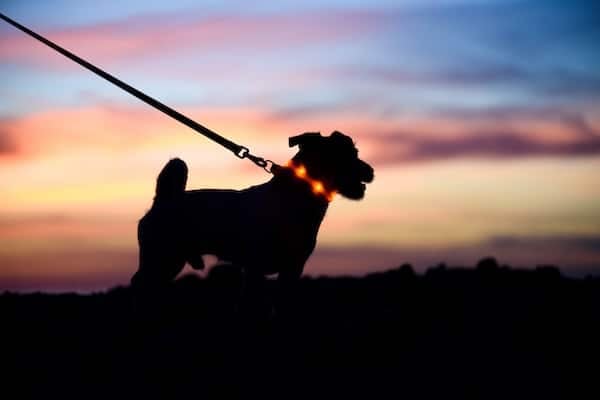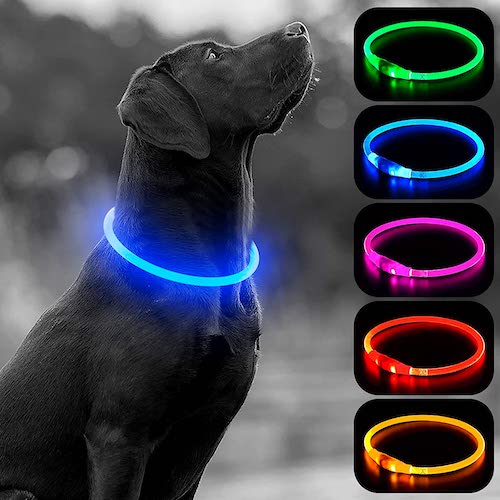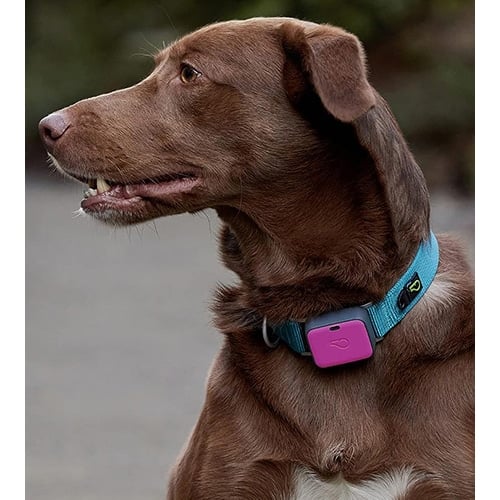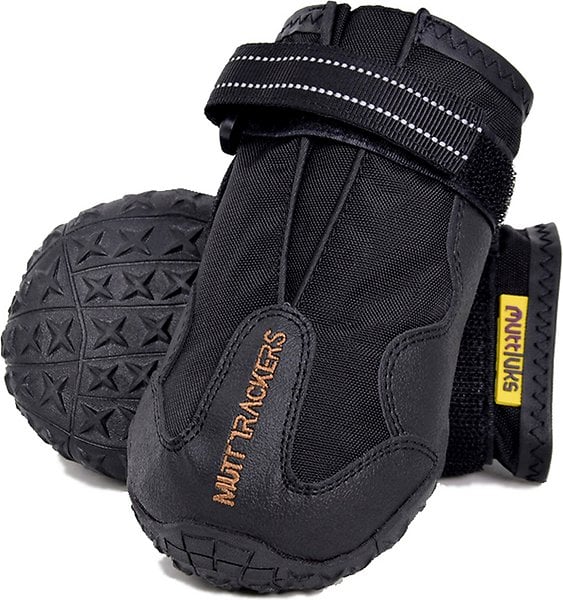- This post contains affiliate links. Read more here.
- Not a substitute for professional veterinary help.
If you work late, have a reactive pup, or live in a hot climate, walking your dog at night can provide relief. But night walks aren’t always a piece of cake, and they can come with disproportionate risks.
According to the U.S. Department of Transportation, 76% of pedestrian fatalities happen at night. Women face a greater risk when walking alone after dark, and older pet parents especially see a higher risk of injury. Low-visibility conditions and the chance of a wildlife encounter also put your pup at risk.
That doesn’t mean night walks are off the table. With the right gear and precautionary measures, you can add significantly to your and your pup’s safety and comfort. To find out the best strategies for adventuring after sundown, we spoke with Dr. Adam Christman, chief veterinary officer for dvm360. We’ll cover risks and benefits, top tips, and beloved gear for safe evening strolls.
Benefits of Walking Your Dog at Night
Walking your dog at night can be a great way to bond with your furry friend and get some exercise at the end of the day. Here are a few other perks.
Night walks can offer fewer distractions
One of the main benefits of walking your dog at night is that fewer people, cars, and other dogs will be out and about. This quiet atmosphere makes it a great time to walk ordinarily skittish dogs or train younger, easily distracted pups.
Plus night walks can provide a calm setting for you and your dog to spend time together and decompress after a long day.
Night walks are less crowded for reactive dogs
Night walks can also be excellent for reactive dogs, since there are fewer triggers, like cyclists, runners, and other dogs. With less commotion, your dog can focus more on you and your training. When your dog’s not always on guard, they can relax, enjoy their walk, take deeper sniffs, and fulfill their needs.
Night walks may be cooler in the summer
In warmer months and in hotter and more humid climates, nightly walks in cooler temperatures can help reduce the risk of heatstroke, dehydration, and other heat-related injuries. This adjustment is especially crucial for dogs who are more susceptible to the heat, like seniors, and certain breeds like brachycephalic or double-coated dogs.
Night walks provide mental stimulation
If your dog has trouble settling before bed, evening walks can give them a good mental workout, so they sleep better at night, points out Dr. Christman. “Nightly walks can also serve as an opportunity for enrichment, exposing dogs to new nocturnal scents and sounds,” he says.

alexei_tm via iStock
What are the Risks of Walking Your Dog at Night?
Despite the advantages, both pet parents and their dogs may feel wary of nighttime strolls.
Dog anxiety
Not all dogs enjoy evening strolls. For some, the lack of visibility or the presence of nocturnal wildlife can be stressful.
“To determine if your dog enjoys night walks, observe their body language,” advises Dr. Christman. “A wagging tail, relaxed posture, and eagerness to move forward indicate enjoyment, while signs of stress include excessive panting, trembling, or pulling back toward home.”
Visibility concerns
Walking in dimly lit conditions can increase the chance of accidents, since it’s more difficult for drivers and cyclists to see you and your pup.
You might also have a harder time navigating your own path in the dark. You might lead your dog over sharp objects, like broken glass, or trip on uneven pavement and take a tumble. If your dog is a scavenger, it will also be harder to see if they’ve picked up something potentially dangerous from the ground.
Safety from people and animals
Unfortunately, walking a dog alone at night, particularly in secluded areas, could make you more vulnerable to crimes.
Nighttime walks can also increase the chances of encountering nocturnal wildlife like skunks, raccoons, foxes, and coyotes. If your dog has a high prey drive, seeing these exciting night creatures could cause them to lunge, pull you down, or break free to chase them.
Gear To Boost Safety at Night
According to Dr. Christman, the right equipment can help you mitigate the risks that come with walking your dog in the dark. “I’m a huge fan of safety gear!” he says. “It’s crucial for ensuring visibility and protection during night walks.”
Flashlights
The best flashlight or light for walking your dog at night will be small and hands-free. If walking in a rural and dimly lit area, opt for a headlamp that’s bright enough for you to see your path.
A weather-resistant light with different modes like this highly rated GearLight headlamp can provide variable visibility, from a clear white strobe to a red safety beam. For an innovative lighting option, there are also LED flashlight gloves that are waterproof and adjustable.
Light-up collars, leashes, and clips
Collars, leashes, harnesses, and other safety equipment with rechargeable LED lights can ensure your dog stands out after the sun goes down. Light-up walking gear that’s water-resistant and has various light modes can help you navigate all types of visibility and weather. The popular HIGO LED Dog Collar, for example, has three modes: quick flash, slow flash, and steady glow. The water-resistant design also makes it easy to wipe down after rainy romps.
If you’re looking to quickly add visibility to your dog’s existing gear, clip-ons like the Nite Ize SpotLit attach to your pup’s leash, collar, harness, treat bag, or jacket.

Available in bright colors, this light-up LED collar has three light modes and can be trimmed down to fit dogs of all sizes.
Reflective gear
If you want to skip the LED lights and the recharging process that comes with them, reflective gear can also make your dog more visible to drivers at night. Collars like the Embark Illuminate Reflective Dog Collar have an entire band around the width that reflects light up to 300 feet away.
When choosing a harness, leash, or safety vest, look for super bright reflective strips and vibrant colors, like what you’ll find on the Rabbitgoo No-Pull Dog Harness.
Booties
Dog boots can protect paw pads from sharp objects on the ground. They’re also great for colder months when the weather can take an unexpected dip after the sun sets. The best booties can handle all types of situations, from rocky terrain to slick ice, and protect sensitive paws in hot, cold, and rainy weather.
Defensive devices
A whistle, personal alarm, or self-defense spray can help protect against potential threats. If worried about wild animals, consider carrying bear spray or another dog-safe animal deterrent, like the PetSafe SprayShield, which uses citronella to deter aggressive animals.
Dr. Christman also recommends the Spleash Leash, which has a handle that doubles as a water bottle that can be used as a squirt gun. “Should there be coyotes or predators coming up to the dog in the evening, the owner can ‘pew pew”’ the predators away with a squirt of water,” he says. An added bonus? Your dog will stay hydrated on your night walks!
GPS trackers
For an extra layer of security, a GPS tracker can help you find your pup if they’re ever spooked and break free on your walks at night. An AirTag can also provide additional safety for a lower price point. However, it’s important to note that AirTags have a much more limited range than a regular GPS tracker. (Your dog must be within 100 feet of another iPhone user.)

This GPS device uses AT&T’s network and Google maps to help you track your pup should they ever get lost at night.
Tips for Walking Safely at Night
While walking a dog at night has many benefits, it requires extra attention and preparation. Here are some tips to help minimize the risks.
- Use well-fitted and secure gear. Always leash up, even if you live in an area without much traffic. A short leash provides better control at night, especially if unexpected distractions, like other animals, appear.
- Choose familiar routes. Stick to well-lit and well-known paths, avoiding shortcuts through dark and unfamiliar areas. Stay away from parks, trails, and other secluded areas when walking alone at night.
- Stay alert. Have your phone easily accessible, but stay off it to avoid distractions. As tempting as it may be to listen to music or a podcast, you’ll also want to leave your headphones off so you’re always aware of your surroundings.
- Wear visible gear. Both you and your pup should wear some type of light-up or reflective walking gear so you’re both visible at night.
- Tell someone where you’re going. Tell a friend, partner, family member, or neighbor where you’re going. Consider sharing your location on your phone so they can track you while you’re out. Better yet, invite them to come along for added security.
- Update tags and microchips. Ensure your dog’s ID tags and microchip details have your most up-to-date contact information in case they get lost.
- Train a solid recall. If your dog breaks free at night, being able to call them quickly back to you can help keep them safe.
Above all, use caution and common sense when walking your dog at night. You don’t need to be afraid, just alert. Combining multiple safety procedures can ensure you and your dog have a safe and enjoyable evening stroll.



